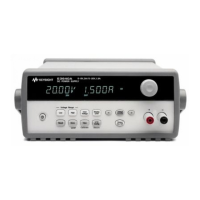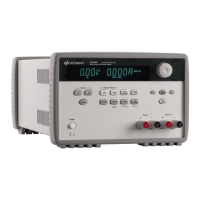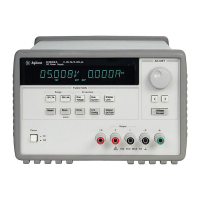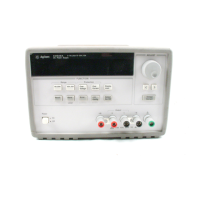Chapter 4 Remote Interface Reference
Calibration Commands
100
Calibration
Example 1 Select the output to be calibrated and enable the output of the power supply by
sending the commands:
‘‘INST:SEL {OUT1|OUT2}’’
‘‘
OUTP ON’’
2 Disable the voltage protection function.
‘‘VOLT:PROT:STAT OFF’’
3 Unsecure the power supply with the secure code before calibration.
‘‘CAL:SEC:STAT OFF, ‘<code>’’’
4 For voltage calibration, connect a digital voltmeter (DVM) across the power
supply’s output terminals.
5 Set the power supply to low-end (MIN) calibration point.
‘‘CAL:VOLT:LEV MIN’’
6 Enter the reading you obtained from the DVM.
‘‘CAL:VOLT:DATA 0.549’’
7 Set the power supply to middle (MID) calibration point.
‘‘CAL:VOLT:LEV MID’’
8 Enter the reading you obtained from the DVM.
‘‘CAL:VOLT:DATA 11.058’’
9 Set the power supply to high (MAX) calibration point.
‘‘CAL:VOLT:LEV MAX’’
10 Enter the reading you obtained from the DVM.
‘‘CAL:VOLT:DATA 21.566’’
11 Set the power supply to overvoltage protection calibration point.
‘‘CAL:VOLT:PROT’’
12 For current calibration, connect an appropriate current monitoring resistor
(shunt) across the output terminals and connect the DVM across the shunt
resistor.
13 Repeat steps (5) through (9) by substituting ‘‘CURR’’ for ‘‘VOLT’’ for current
calibration. For example, ‘‘CAL:CURR:LEV MIN’’
14 Repeat steps (1) through (13) for the other output calibration.
15 Record calibration information such as next calibration due date or contact
person for future reference. The calibration string may contain up to 40
characters.
‘‘CALibration:STRing ‘<string>’’’
Notice: You should wait for the DVM reading to stabilize for accurate calibration.

